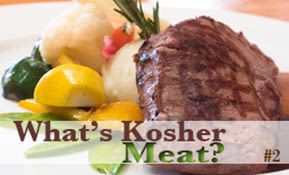
The Kosher Primer, Part 1
With so many of our readers new to Jewish observance, we’re delighted to host Rabbi Yaakov Luban from the OU, who teaches us the practical basics of keeping kosher.

The Kosher Primer, Part 1
Introduction:
The Hebrew word kosher means fit or proper as it relates to kosher dietary law. Kosher foods are permitted to be eaten, and can be used as ingredients in the production of additional food items.
The basic laws of Kashrus (a Hebrew word referring to kosher and its application) are of Biblical origin (Leviticus 11 and Deuteronomy 17). For thousands of years, Rabbinic scholars have interpreted these laws and applied them to contemporary situations. In addition, Rabbinic bodies enacted protective legislation to safeguard the integrity of kosher laws.
The laws of kashrus are complex and extensive. The intention of this guide is to acquaint the reader with some of the fundamentals of kashrus and provide insight into its practical application. Given the complex nature of the laws of kashrus, one should consult an Orthodox Rabbi whenever a kashrus issue arises.
Though an ancillary hygienic benefit has been attributed to the observance of kashrus, the ultimate purpose and rationale is to conform to the Divine Will, as expressed in the Torah.
Not too long ago, most food products were made in the family kitchen, or in a small factory or store in the local community. It was relatively easy to ascertain if the product was reliably kosher. If Rabbinical supervision was required, it was attended to by the rabbi of the community, who was known to all. Today, industrialization, transcontinental shipping and mass production have created a situation where most of the foods we eat are treated, processed, cooked, canned or boxed commercially in industrial settings, which can be located hundreds or thousands of miles away from home.
What adds further complication is that it is generally not possible to judge the kosher status of an item on the basis of the information provided in the ingredient declaration for a variety of reasons.
First, the product may be made from kosher ingredients, but processed on non-kosher equipment. Second, the USDA does not require the listing of certain processing aids, such as pan liners and oils that serve as release agents. Though not legally classified as ingredients, these items could nonetheless render the product non-kosher. Third, many ingredients can be kosher or non-kosher, depending on their source of origin. For example, glycerin and emulsifiers are made from either vegetable or animal oils. Finally, many ingredients are listed only in broad terms, with no breakdown of the many complex components that make up the actual item. For example, a chocolate flavor may contain 50 ingredients, but the ingredient declaration will list this entire complex of ingredients as “flavors”.
Unless a person is an expert in food production, the average consumer cannot possibly make an evaluation of the kosher status, which is why it is important to purchase only those products that have the endorsement of a reliable kosher agency.
2. Kosher and Non-Kosher Meat, Poultry, and Fish
A. Meat:
The Torah states that kosher mammals are those which chew their cud (ruminants) and are cloven-hoofed. The following animal species are among those considered to be Kosher: Addax, Antelope, Bison, Cow, Deer, Gazelle, Giraffe, Goat, Ibex and Sheep. In addition, meat and poultry require special preparation, which will be discussed below.
B. Poultry:
The Torah does not enumerate specific characteristics to distinguish permitted and forbidden birds. Instead, it enumerates 24 forbidden species of fowl, while all other birds are considered to be kosher. Nonetheless, for various reasons, in practice we eat only those birds which have an established tradition that the species is kosher.
In the United States, the only poultry accepted by mainstream kashrus organizations as kosher are chicken, turkey, duck and goose.
C. Fish:
The Torah establishes two criteria to determine what are kosher fish. The fish must have fins and scales. The scales must be easily removable without damaging the skin. [Generally, scales on kosher fish are either thin, rounded and smooth-edged (cycloid) or narrow segments that are similar to teeth of a comb (ctenoid)]. All shellfish are prohibited. Unlike meat and poultry, fish requires no special preparation. Nonetheless, the fish scales must be visible to the consumer in order to establish the kosher status of the fish. Therefore, filleted or ground fish should not be purchased unless properly supervised, or the fillet has a skin tab with scales attached to the flesh. Furthermore, purchasing fish in a non-kosher fish store is problematic, even if the scales are intact, because the knives and tables are not kosher, and Rabbinic guidance should be sought.
Rabbinic law prohibits consumption of fish and meat together.
Processed and smoked fish products require reliable rabbinic supervision, as do all processed foods.
* * *
To be continued.
(Reprinted with permission of http://www.ou.org/)












Tell us what you think!
Thank you for your comment!
It will be published after approval by the Editor.